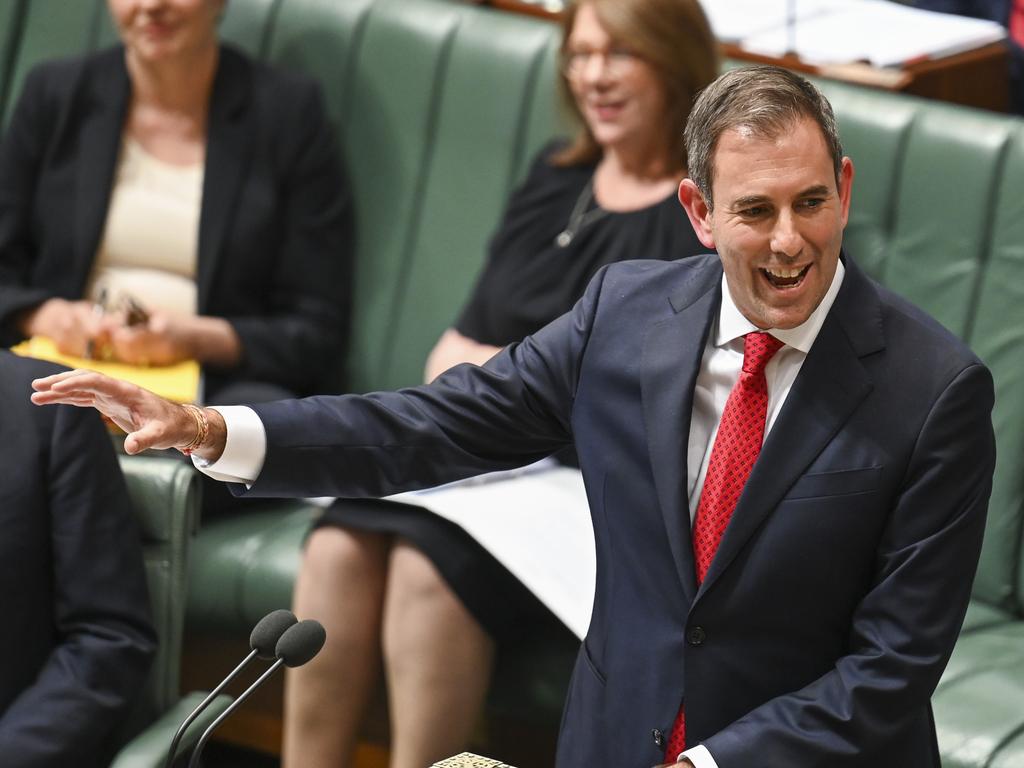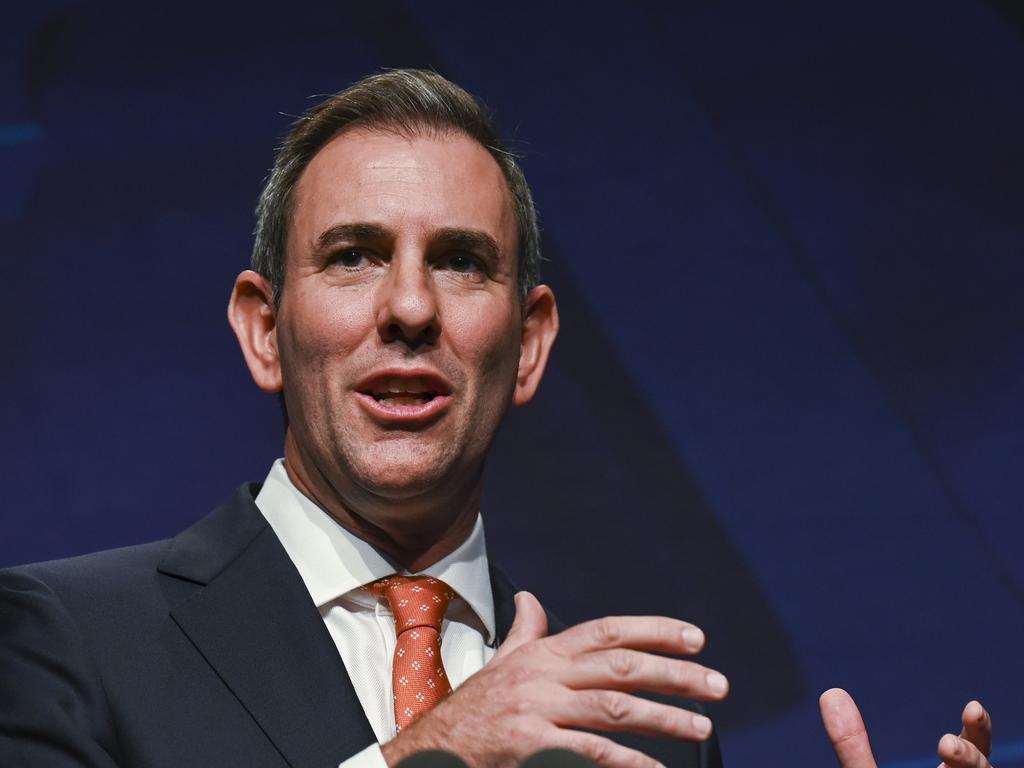The Josh & Jim surplus: Why Chalmers should be thanking Frydenberg
Labor’s surprise surplus is truly a bipartisan effort – as are the grim years of forever deficits because the size of government keeps expanding.

The budget is essentially in underlying cash balance after a fiscal recovery of 6.6 per cent of GDP in just two years, or $167bn better off in today’s dollars.
Paul Keating in the 1980s and Peter Costello in the ’90s put up excellent consolidation numbers, via different ways and means, but nothing as remarkable as this joint enterprise by Josh Frydenberg and Jim Chalmers.
Our two most recent custodians shouldn’t mind sharing the glory, right, given a year ago the taxing and spending options offered to voters by the Coalition and Labor were virtually mirror images, with enough at the margins of each budget framework to effect crossover partisan branding. Rules? There are no fiscal rules!
Ultimately, the election was decided on leadership (ScoMo v Albo), longevity (old v new) and cost of living (less is more). The Australian Election Study also revealed Labor’s small-target strategy helped to put more attention on the Morrison government’s pandemic management, as voters marked down Canberra’s performance compared with state governments.
As well, the seminal Australian National University post-poll survey of voters found the Coalition’s advantage in several policy areas, most tellingly the economy, was reduced or eliminated, as more voters saw no difference between the parties on public policy. Hence, as the Josh & Jim show reveals, continuity with change.

There’s some budget voodoo going on, for sure; the magic of bracket creep is at large, when more people are working, wages are rising, while the tax brackets are “set and forget”, for at least another year. Inflation has pumped up the economy during the past two years. We’ve had double-digit growth each year in the nominal or dollar value of gross domestic product. That’s what gets taxed.
Then there’s a record 400,000 net inflow of foreign students, backpackers and workers, who spend more than they cost governments in services. Treasury estimates net overseas migration will be 315,000 next financial year, and then 260,000 a year later. This is not a Big Australia push, although officials have been caught out by the surge in the number of students, particularly from China.
The policy changes flagged by Home Affairs Minister Clare O’Neil after the migration review and a return to normal in the student arrival dynamic will ease population growth across the decade. Our population is undergoing a secular switch, long in the making, but now more pronounced; the number of migrants expected before the pandemic will fully recover by decade’s end. But the population will be 750,000 people smaller by 2031 because of a plunge in fertility.
Revenue is the protagonist behind the budget drama and the nation’s economic redemption. The bulk of the value of so-called automatic stabilisers (Eco 101: mechanisms built into government budgets that increase spending or decrease taxes when the economy slows) comes from changes in tax revenues rather than from spending on programs. They move in line with economic growth.
According to the US Congressional Budget Office, revenues have accounted for about three-quarters, on average, of the effect of automatic stabilisers on the budget across the past five decades. Studies have shown the stimulus here is stronger from the revenue channel than in the US.
Even with the stage three tax cuts, which begin in July next year and cost an estimated $69bn in their first three years, tax receipts just keep rolling, rolling home. Since Frydenberg’s pre-election cash splash in March last year, Treasury estimates the tax take will be $252bn higher across the four years of that budget.
In his two budgets, Chalmers has made policy decisions that bring in an extra $21bn in tax across the four years that end in June 2026, so the economy (meaning migrants, employment gains, pay rises, profits, consumer spending) has delivered the rest.
Turning to the spending or payments side, we have had political slippage, as well as sneaky, maybe reckless, ploys by the previous government in not fully funding programs and institutions that are accepted as part of the furniture, such as health and digital services. Labor has had to cough up.
But there also has been an attempt by the Surplus Brothers to tighten the screws. Labor’s “rorts and waste” audit has done what every new government does when it has the energy and doesn’t mind offending the folks who’ll never trouble them with their vote.
Chalmers appears to have kept rising defence costs at bay for now, but the big challenge will be wrestling with the National Disability Insurance Scheme’s bottom-up growth. The strategy is to impose cost control from above, squeeze the envelope, and see whether the NDIS review can deliver efficiencies without politically nigh impossible legislative changes to its mission.
Still, the Morrison government’s pandemic response has permanently increased the size of government; while Labor keeps baking in more social programs, and redistributing income support to its traditional constituency, it’s a wonder the expenditure review committee has held the line on so many fronts.

It’s true much of the Coalition’s crisis spending blowout was “temporary and targeted”, as it kept telling us. Across the key two pandemic years, spending grew by a cumulative 30 per cent in real terms. In the following two years, as one-off economic and health programs expired, Frydenberg was hoping to cut spending in real terms by a cumulative 11.2 per cent (according to his last budget).
We now learn he did much better in his last year in office (a 9.8 per cent cut after inflation). Then Chalmers picked up the knife in the current financial year and trimmed real spending by an estimated 4.3 per cent (slightly less than Frydenberg was hoping for on paper, but at least the Treasurer looks as if he’ll actually achieve it).
Because the economy is so much larger now, Canberra’s spending is only slightly bigger than it was before the pandemic. But payments will grow as a share of GDP during the next few years.
The Treasurer insists on using the more flattering five-year figure, which brings down the annual average to a high distinction 0.6 per cent – especially in the face of inveterate-spending ministers, unions and the social welfare lobby.
But that’s positive PR, and this is journalism.
In Tuesday’s budget Chalmers and Finance Minister Katy Gallagher kept real spending growth to an average of 1.8 per cent a year across the forward estimates. On balance, even at this early stage, the Treasurer has made tougher decisions than his predecessor.
Enough with the numbers, although it is budget week and you’re not here for the larks.
Post-pandemic, we’ve locked in bigger government and deficits for the next 10 years, getting smaller on herculean assumptions.
Those deficits, too, are a bipartisan enterprise, stretching back to the social spendathons of Howardism, Julia Gillard’s education and disability monuments, and all manner of junk accumulated across three Coalition terms.
We still haven’t found a way to pay for it, other than the stealth of fiscal drag, which means taking a higher chunk of tax out of workers’ pockets because of wage inflation (even when they stay in the same tax bracket).
Treasury loves it. Canberra’s coffers swell without the policy and political stench of TAX HIKE headlines. Can you imagine if we had automatic indexation of personal income tax, as they do in the US, Canada, Belgium, Israel, Denmark, The Netherlands and several other countries? We’re on our way for the average personal income tax rate to hit a record; that source delivers half the tax take.
We can’t continue to rely on personal income tax to do the heavy lifting in our system. It’s risky, inefficient and counter-productive: bracket creep discourages workforce participation for those on low incomes and creates incentives for tax planning and structuring at the top end.
Taxing better, rather than in our half-arsed, sneaky and dumb-luck way, seems like a Neverland. Same goes for getting more for taxpayer-funded services, no matter who delivers them.
Labor must confront its reform demons to raise living standards, accelerate decarbonisation, promote competition, stimulate investment – and not scrimp on diplomacy, security and decency. Jim can run but not hide from these tax and spending malignancies. He’ll need a lot more help from officials, colleagues, opponents and voters to find a cure.








The Josh & Jim surplus is a stunning turnaround, built on the obsolescence of Covid emergency stimulus and, since the election, an $80bn improvement in tax receipts for a single year. Australian taxpayers, and there are a lot more of us now, take a bow and watch your wallets.